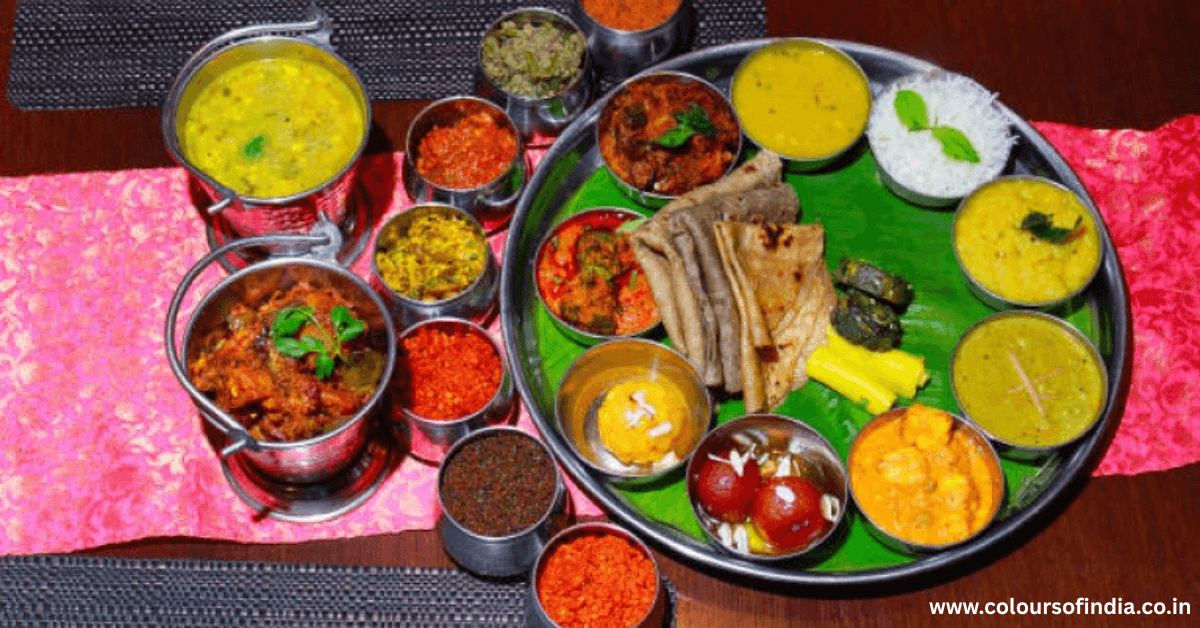Traditional Maharashtrian Thali – A Complete Meal with Culture on a Plate
In Maharashtra, food is more than just sustenance—it’s a celebration of culture, tradition, nutrition, and hospitality. The Traditional Maharashtrian Thali is not just a meal; it’s an expression of balance, community, and love served on a single platter.
Every component of the thali—whether spicy, tangy, sweet, or crunchy—has its place and purpose. The dishes reflect the region’s agricultural abundance, seasonal produce, ritual purity, and flavor diversity. In this detailed vlog/blog, we’ll explore each item of a Maharashtrian Thali, how it’s prepared, and why it matters.
🍽️ What is a Maharashtrian Thali?
A thali means “plate” in Marathi. A Maharashtrian Thali typically includes multiple small bowls (katoris) arranged on a large plate, with rice or bhakri/chapati at the center, and a selection of lentils, vegetables, condiments, and sweets surrounding it.
It’s nutritionally balanced, follows Ayurvedic principles, and is designed to satisfy all six tastes: sweet, sour, salty, pungent, bitter, and astringent.
🪔 When is it served?
A traditional thali is often prepared on:
Festivals and religious occasions
Family gatherings or ceremonies
Weddings and special events
Temple feasts or “Prasad” meals
It can also be enjoyed daily in many Maharashtrian homes, especially in rural or semi-urban areas.
🧂 Typical Components of a Traditional Maharashtrian Thali

🫓 1. Bhakri / Chapati
Bhakri is an unleavened flatbread made of jowar (sorghum), bajra (pearl millet), or nachni (ragi).
Chapatis are made from wheat and are softer and lighter.
These serve as the main accompaniment to vegetables, dals, and chutneys.
🍚 2. Bhaat (Rice)
Steamed white rice is a staple.
Sometimes served with a spoonful of ghee (clarified butter).
Often accompanied by Varan (plain dal) or Amti (spicy dal).
🥣 3. Varan / Amti
Varan is a simple toor dal (pigeon pea) preparation with turmeric, cumin, and a hint of jaggery.
Amti is a spiced dal using goda masala, kokum/tamarind, and jaggery, striking a balance between sweet, sour, and spicy.
🥘 4. Vegetable Sabzi / Bhaji
Seasonal vegetables like bhendi (ladyfinger), gavar (cluster beans), kobi (cabbage), bharli vangi (stuffed eggplant), or dudhi (bottle gourd).
Prepared with mustard seeds, hing (asafoetida), turmeric, and sometimes coconut.
🌱 5. Usal / Misal
Made from sprouted legumes such as matki (moth beans), moong, or chawli (black-eyed peas).
Usal is a dry or semi-dry version, while Misal is spicy with gravy, topped with farsan and served with pav.
🥗 6. Koshimbir (Salad)
A refreshing side dish of cucumber, tomato, or carrots, often mixed with curd, roasted peanuts, and tempered mustard seeds.
Provides coolness and crunch to the thali.
🫙 7. Chutney & Thecha
Dry chutneys made of roasted peanuts, garlic, sesame, and coconut.
Thecha is a spicy green chili-garlic paste—a fiery condiment popular in rural areas.
🥒 8. Pickles (Loncha)
Homemade pickles of raw mango, lemon, or green chili.
Adds a sour and spicy kick to the meal.
🍘 9. Papad (Fried or Roasted)
Made from urad dal or rice flour.
Roasted or fried, it gives a crunchy contrast to soft rice and dals.
🍮 10. Sweet Dish (Goda)
Puran Poli – Sweet chana dal and jaggery stuffed flatbread.
Shrikhand – Hung curd sweetened with sugar and cardamom.
Kharvas – Milk pudding made from colostrum.
Gulab Jamun, Basundi, or Ladoo during festive occasions.
🥛 11. Buttermilk / Solkadhi / Taak
Taak (buttermilk) is spiced and tempered, aiding digestion.
Solkadhi is a coastal favorite—made from kokum and coconut milk.
Traditional Maharashtrian Thali Traditional Maharashtrian Thali Traditional Maharashtrian Thali Traditional Maharashtrian Thali Traditional Maharashtrian Thali Traditional Maharashtrian Thali
🧘 Balanced Nutrition and Ayurvedic Wisdom
A Maharashtrian Thali follows the Ayurvedic principle of “Shadrasa” (six tastes) to promote digestion and well-being:
Sweet – Puran Poli or rice
Sour – Pickle or Solkadhi
Salty – Sabzi or dal
Pungent – Thecha or spices
Bitter – Green leafy bhaji or methi
Astringent – Sprouts or legumes
It’s wholesome, fiber-rich, and gut-friendly, designed to cleanse and nourish the body.
🏡 Homemade vs. Restaurant-Style Thali
While homemade thalis focus on freshness and traditional recipes, restaurant-style thalis tend to be elaborate and festive, featuring up to 20–25 items.
Some well-known places in Maharashtra serving traditional thalis include:
Shreyas (Pune)
Rama Bhavan (Kolhapur)
Aaswad & Prakash (Mumbai)
🧡 The Emotional Connect
Eating a Maharashtrian Thali is a sensory experience:
The smell of hot bhakri with ghee,
The warmth of varan-bhaat with lemon,
The spice of thecha that brings tears (and joy),
The sweetness of puran poli that melts hearts.
It’s not just about food—it’s about belonging, identity, and tradition.
The Traditional Maharashtrian Thali is a culinary portrait of Maharashtra—simple, hearty, flavorful, and rooted in tradition. Whether you’re tasting it in a village home, a city restaurant, or preparing it yourself, you’re engaging with centuries of food wisdom.
It’s more than a meal—it’s culture, family, and festivity on a plate.
To read detailed information about Maharashtrian Food Culture Click here.